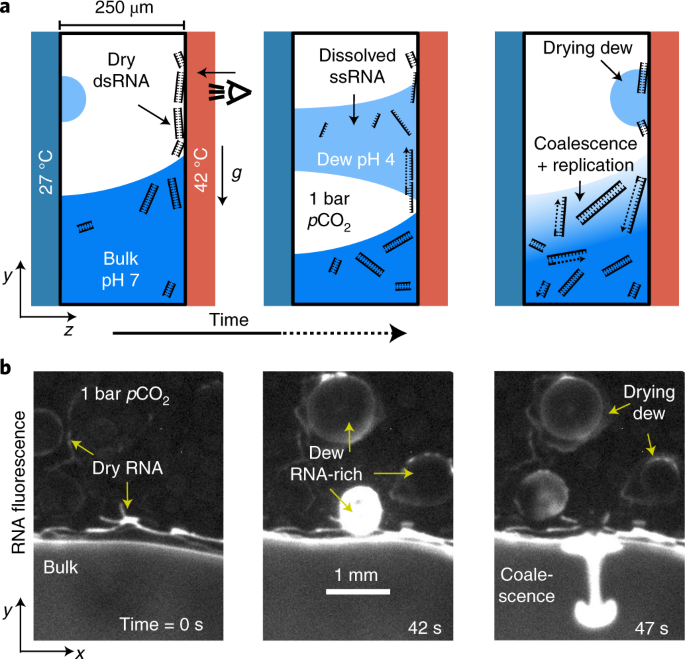自由浮遊惑星は、太陽の周りを回っていません。その衛星には液体の水が残っている可能性があり、生命が誕生するための基礎となる。ミュンヘンに拠点を置く研究者たちは、このたび、その必要な性質を突き止めた。 Free-floating planets do not orbit a sun. Their moons may still have liquid water, and thus the basis for the emergence of life. Munich-based researchers have now determined the necessary properties.
2023-03-20 ミュンヘン大学(LMU)
それが可能なのは、生息可能な領域を外れた惑星に属する場合でも、変動する潮汐力のような恒星熱以外の熱源を持つ必要があるためです。実際、土星の衛星エンケラドスは、潮汐加熱のおかげで、氷の外殻の下に液体の水の海を隠しています。
また、孤独な漂流惑星に付随する衛星にも生命が存在する可能性があります。しかし、その場合は、地球に比べて100倍もの水分を含んだ惑星の周りを回る地球サイズの衛星が必要です。このような新しい、予期しない場所で生命が形成される可能性があります。
<関連情報>
- https://www.lmu.de/en/newsroom/news-overview/news/life-on-distant-moons.html
- https://www.cambridge.org/core/journals/international-journal-of-astrobiology/article/presence-of-liquid-water-during-the-evolution-of-exomoons-orbiting-ejected-freefloating-planets/0F01ACB0AB373E87BB30D1DDA6F45800
放出された自由浮遊惑星を周回するエクソモーンの進化過程における液体の水の存在 Presence of liquid water during the evolution of exomoons orbiting ejected free-floating planets
Giulia Roccetti,Tommaso Grassi,Barbara Ercolano,Karan Molaverdikhani,Aurélien Crida,Dieter Braun and Andrea Chiavassa
Cambridge University Press Published:20 March 2023
DOI:https://doi.org/10.1017/S1473550423000046

Abstract
Free-floating planets (FFPs) can result from dynamical scattering processes happening in the first few million years of a planetary system’s life. Several models predict the possibility, for these isolated planetary-mass objects, to retain exomoons after their ejection. The tidal heating mechanism and the presence of an atmosphere with a relatively high optical thickness may support the formation and maintenance of oceans of liquid water on the surface of these satellites. In order to study the timescales over which liquid water can be maintained, we perform dynamical simulations of the ejection process and infer the resulting statistics of the population of surviving exomoons around FFPs. The subsequent tidal evolution of the moons’ orbital parameters is a pivotal step to determine when the orbits will circularize, with a consequential decay of the tidal heating. We find that close-in (a≲25 RJ) Earth-mass moons with carbon dioxide-dominated atmospheres could retain liquid water on their surfaces for long timescales, depending on the mass of the atmospheric envelope and the surface pressure assumed. Massive atmospheres are needed to trap the heat produced by tidal friction that makes these moons habitable. For Earth-like pressure conditions (p0 = 1 bar), satellites could sustain liquid water on their surfaces up to 52 Myr. For higher surface pressures (10 and 100 bar), moons could be habitable up to 276 Myr and 1.6 Gyr, respectively. Close-in satellites experience habitable conditions for long timescales, and during the ejection of the FFP remain bound with the escaping planet, being less affected by the close encounter.
ハデアンのCO2大気中の水循環が長いDNAの進化を促す Water cycles in a Hadean CO2 atmosphere drive the evolution of long DNA
Alan Ianeselli,Miguel Atienza,Patrick W. Kudella,Ulrich Gerland,Christof B. Mast & Dieter Braun
Nature Physics Published:17 March 2022
DOI:https://doi.org/10.1038/s41567-022-01516-z

Abstract
Dew is a common form of water that deposits from saturated air on colder surfaces. Although presumably common on primordial Earth, its potential involvement in the origin of life in early replication has not been investigated in detail. Here we report that it can drive the first stages of Darwinian evolution for DNA and RNA, first by periodically denaturing their structures at low temperatures and second by promoting the replication of long strands over short, faster replicating ones. Our experiments mimicked a partially water-filled primordial rock pore in the probable CO2 atmosphere of Hadean Earth. Under heat flow, water continuously evaporated and recondensed as acidic dew droplets that created the humidity, salt and pH cycles that match many prebiotic replication chemistries. In low-salt and low-pH regimes, the strands melted at 30 K below the bulk melting temperature, whereas longer sequences preferentially accumulated at the droplet interface. Under an enzymatic replication to mimic a sped-up RNA world, long sequences of more than 1,000 nucleotides emerged. The replication was biased by the melting conditions of the dew and the initial short ATGC strands evolved into long AT-rich sequences with repetitive and structured nucleotide composition.



